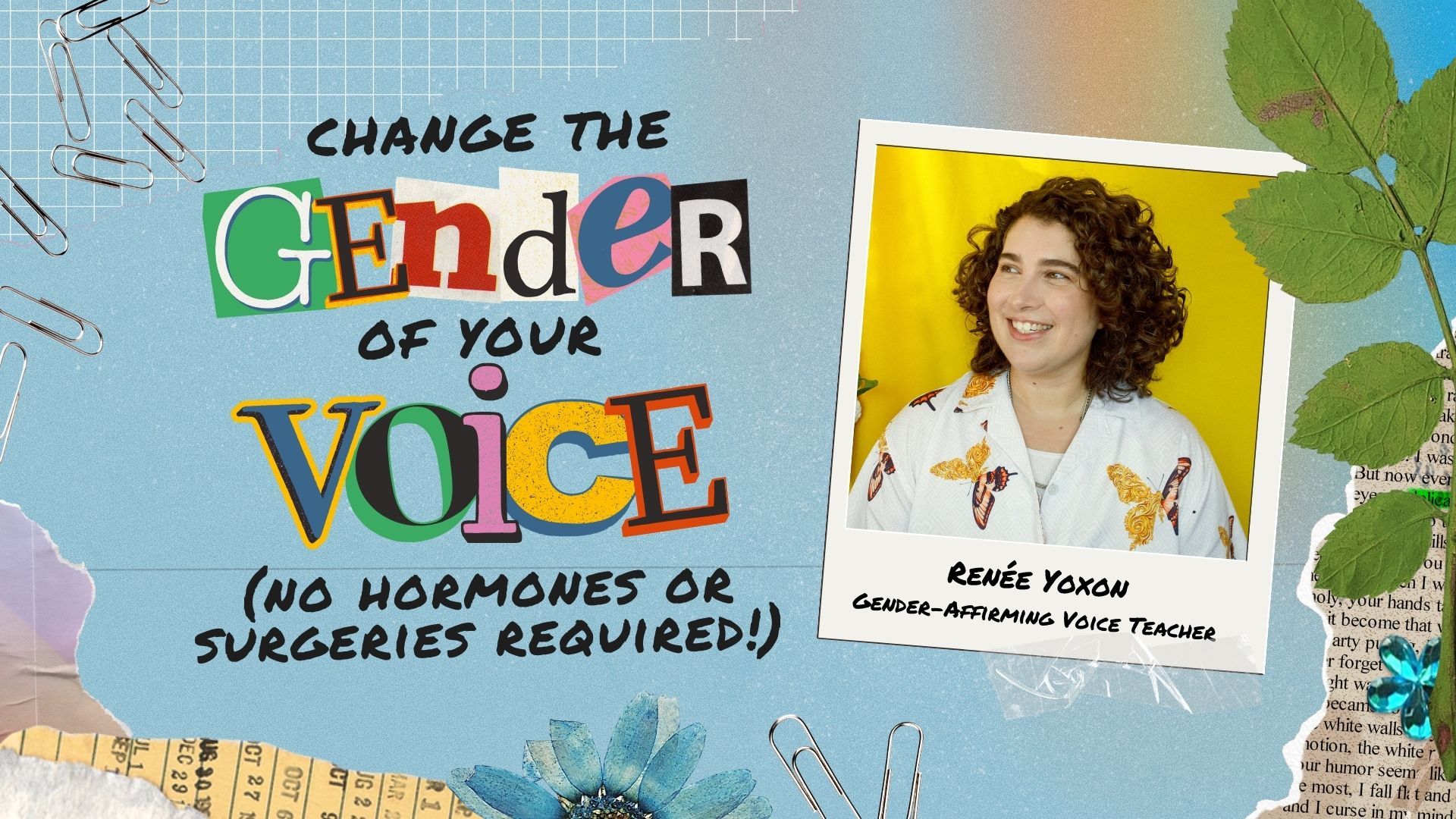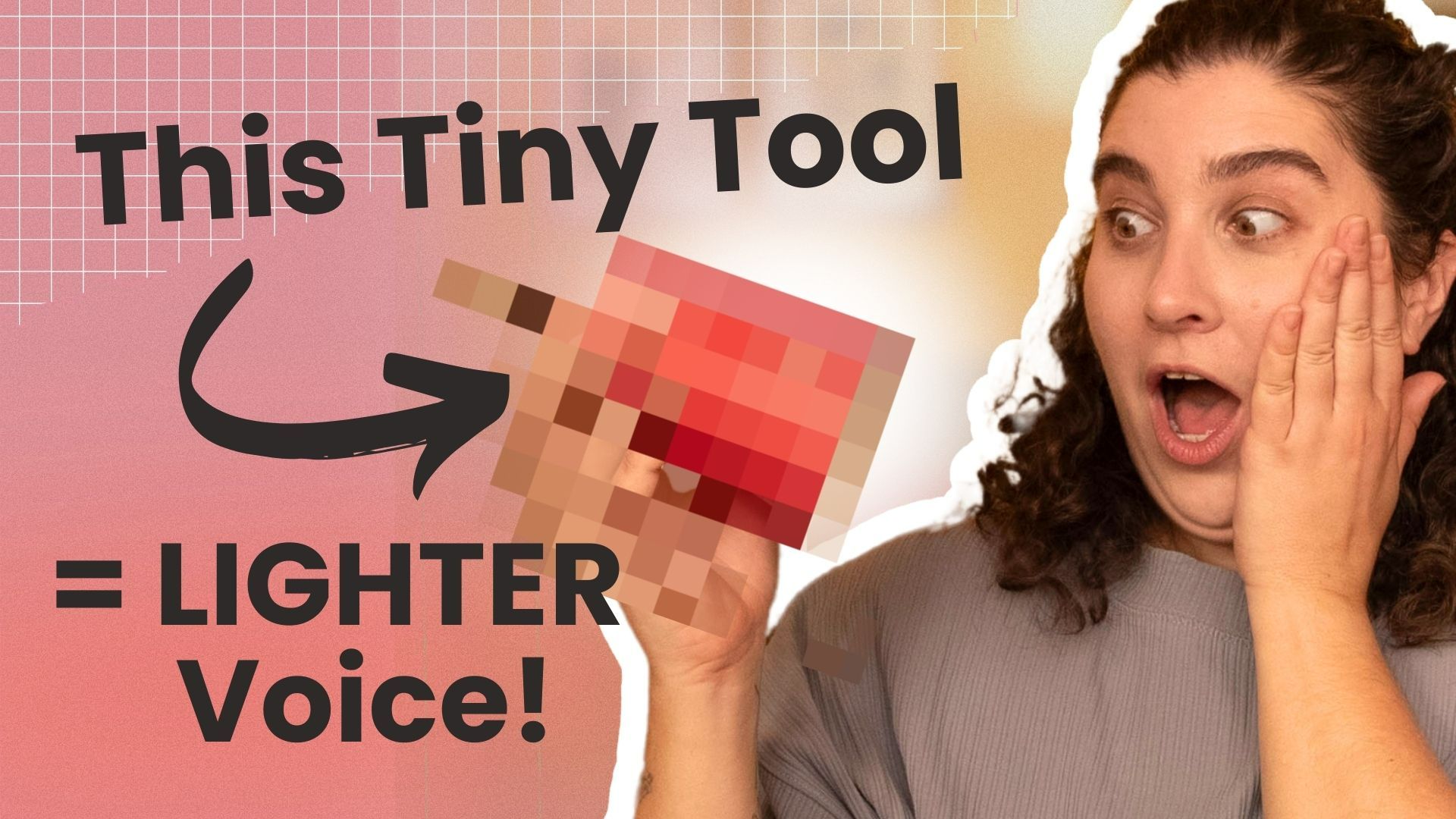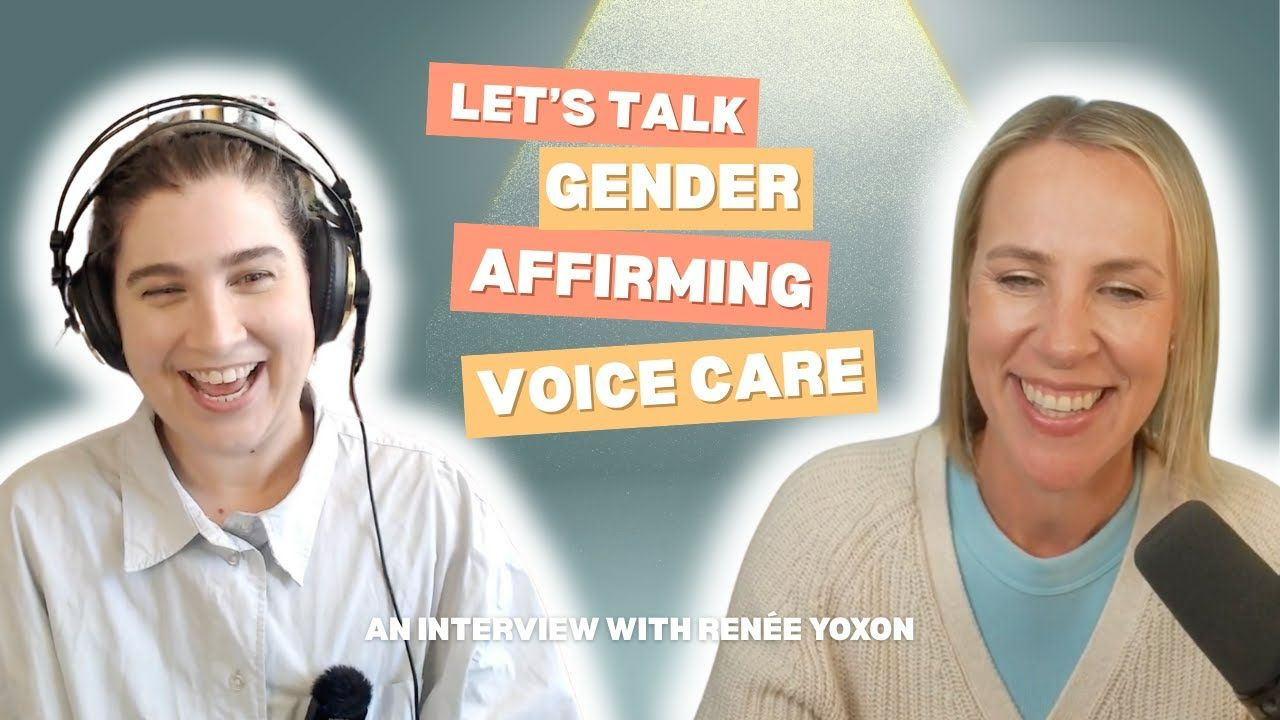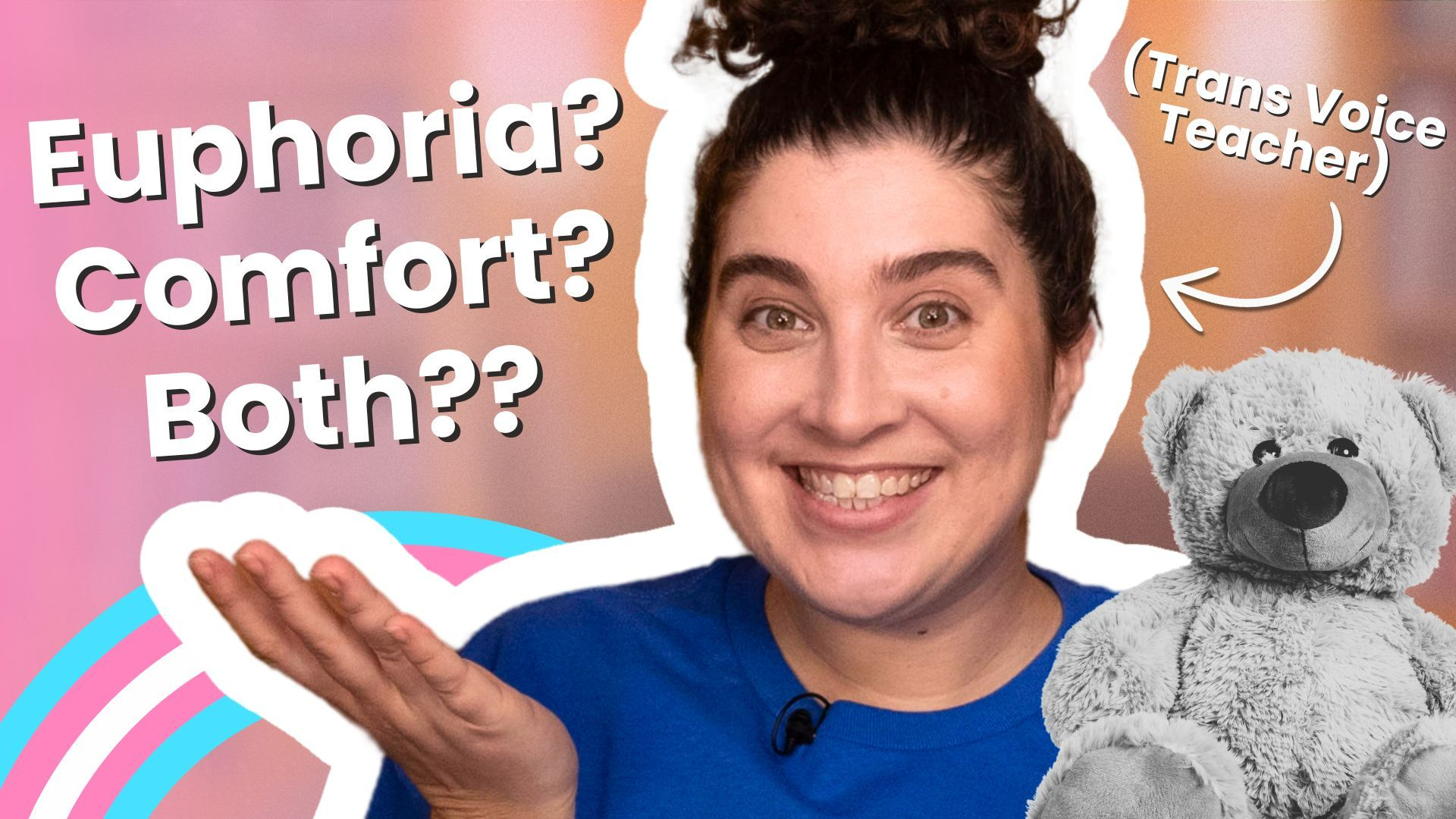Trans Voice Would-You-Rather: 11 Hilarious Questions That Teach Real Voice Training Lessons
Nov 13, 2025
Let's be real: we're all a little burnt out these days. Between navigating the world as trans, nonbinary, and gender-expansive people, and the constant work of gender-affirming voice training, sometimes we need to step back and have a little fun.
That's exactly what my editor, Tea, and I did in this week's video: we played Trans Voice Would-You-Rather, a game that forced us to confront hard truths like whether we'd rather be trapped forever in customer service voice or accidentally slip into anime girl voice during a job interview.
But don't think that just because we're having fun, you won't learn something. Each of these ridiculous scenarios actually reveals important lessons about trans voice training, and what really matters in your voice feminization or masculinization journey.
Table of Contents
- Watch the Full Video
- Would You Rather: Straw Phonation in Public or Explain Resonance Again?
- Would You Rather: Misgender Yourself or Trust Voice Tools?
- Would You Rather: Perfect Voice Only in the Shower or Decent All the Time?
- Would You Rather: Perfect Pitch or Perfect Resonance?
- Would You Rather: Internal Confidence or External Validation?
- Would You Rather: Practice with Voice Memos or Get Feedback from Strangers?
- Would You Rather: Pitch Tracker Following You or Public Spectrograms?
- Would You Rather: Perfect Voice in Second Language or Neutral in All?
- Would You Rather: Voice Fluctuates with Mood or Emotionally Flat?
- Would You Rather: Instant Progress That Disappears or Slow Realistic Growth?
- Would You Rather: Customer Service Voice Forever or Anime Girl in Interview?
- Key Takeaways for Trans Voice Training
- Free Resources
Watch the Full Video
Prefer to read? Keep scrolling for all 11 would-you-rather questions, our answers, and the voice training lessons hidden in each scenario.
Would You Rather: Do Straw Phonation in Public or Explain What Resonance Means to Your Cis Roommate Again?
Tea's answer: Explain resonance again
Renée's answer: Straw phonation in public (and I've actually done it!)
The Voice Training Lesson
This question highlights something important about trans voice training: a lot of what we do looks or sounds weird to outsiders, but it's incredibly effective.
Straw phonation is a semi-occluded vocal tract exercise that's nearly silent unless you're right next to someone. I've literally sat in busy parks doing straw phonation exercises with my Singing Straw, and nobody noticed or cared.
The social anxiety around voice practice is often worse than the reality. And honestly? If you have to choose between practicing your voice in public or trying to explain vocal resonance to someone who doesn't get it, pick the practice. Your progress matters more than other people's opinions.
Want to learn more about straw phonation? Check out these three straw phonation posts:
Would You Rather: Accidentally Misgender Yourself on a Zoom Call or Have Voice Tools Tell You You're 17% Feminine and 83% Chaos?
Both our answers: Voice tools chaos
The Voice Training Lesson
This scenario reveals an important truth about voice feminization training tools and technology: they're helpful guides, but they're not perfect judges of your voice.
As Tea pointed out (with her audio-visual background), voice analysis apps can be temperamental. The proximity effect means that if you're too close to your microphone (like with earbuds), certain frequencies get exaggerated, making you sound deeper than you actually are.
Other factors that affect Voice Tools' readings include:
- Microphone quality and placement (6 inches is ideal for most mics)
- Background noise and acoustic environment
- Noise cancellation features on apps
- Inconsistent recording setups between practice sessions
The takeaway? Use Voice Tools as one data point among many, not as the ultimate authority on your progress. And for comprehensive guidance, watch my video about Voice Tools.
Would You Rather: Nail the Exact Voice You Want, But Only in the Shower, or Sound Decent 100% of the Time But Never Quite Right?
Both our answers: Sound decent 100% of the time
The Voice Training Lesson
This is actually a trick question, and here's why: there is no perfect voice.
As Tea said, "Nothing in your transition is perfect." After 10 years of transition experience, she knows that things rarely go exactly as planned. You figure out what works with what you're working with.
In transgender voice training, you're always moving in a direction, not toward some fixed ideal. You might discover something you like even more than what you thought you were aiming for. That's not failure, that's growth.
The "90% of the way there" that feels achievable and sustainable is far more valuable than some mythical perfect voice you can only access in optimal conditions.
Would You Rather: Control Pitch Perfectly But Have Zero Resonance Control, or Have Impeccable Resonance But Your Pitch is a Mystery?
Both our answers: Perfect resonance control
The Voice Training Lesson
This question gets to the heart of what many people misunderstand about voice feminization therapy and masculine voice training.
When you first start trans voice lessons, it's easy to think pitch is everything. Higher equals feminine, lower equals masculine, right?
Wrong.
Resonance does far more heavy lifting than pitch when it comes to gendered voice perception. There is a natural overlap in the pitch ranges of masculine and feminine voices. What really creates that gendered perception is vocal resonance—the brightness or darkness of your voice.
As I explained in the video, plenty of women have lower-pitched voices. What makes them sound feminine isn't the musical note they're speaking on, it's the resonance, weight, and other vocal qualities they're using.
For transgender vocal training, mastering resonance control opens up possibilities that pitch alone never could. You can make almost any pitch work if you nail the resonance.
Learn more about the difference between pitch and resonance in these related posts:
Would You Rather: Be 100% Confident in Your Voice But Only When Speaking to Yourself, or Be Consistently Gendered Correctly But Still Feel Uncertain?
Tea's answer: Consistently gendered correctly (for safety and ease of life)
Renée's answer: 100% confident (because that's actually my reality as a nonbinary person)
The Voice Training Lesson
This question reveals the difference between internal gender euphoria and external validation in gender-affirming voice training.
As a nonbinary person, I shared that I experience the first scenario: I look in the mirror and see a nonbinary person looking back. I feel secure in my gender identity. But in public, I'm constantly misgendered as "miss" or "ma'am" because our society doesn't have widespread recognition of nonbinary presentation.
The revelation? It doesn't affect me much on a day-to-day basis because I know who I am. The people who matter to me, like my partner, my friends, and my community, gender me correctly.
Tea pointed out important practical considerations: being consistently gendered correctly has real safety implications and makes daily life easier, especially "as we head slowly into the colder months" when more layers can affect how people perceive gender.
Both answers are valid. Your trans voice training goals should reflect what matters most to you: internal confidence, external perception, or both.
I go into detail about this in my post on five reasons people start trans voice training.
Would You Rather: Spend a Week Practicing Only with Your Voice Memos App or Only with Unfiltered Feedback from Cis Strangers?
Both our answers: Voice memos app
The Voice Training Lesson
Tea put it perfectly: "I hate, hate, hate listening to myself, but I would rather be unalive than deal with an entire week of cis strangers evaluating my gender performance, even if they're well-meaning"
This really puts the discomfort of listening to voice recordings in perspective, doesn't it?
Many people in fem voice training or ftm voice therapy avoid recording themselves because they can't stand hearing their own voice. But consider the alternative: subjecting yourself to constant evaluation and feedback from people who may not understand your goals, may not use appropriate language, or may inadvertently cause dysphoria with their "helpful" comments.
Recording yourself is useful for tracking progress in vocal feminization training or masculinization. It's uncomfortable at first, but it's infinitely better than the alternative.
Pro tip: You don't have to listen to recordings immediately. Make them, date them, and review them weeks or months later when you have more emotional distance.
But if you absolutely can't stomach the idea of listening to recordings of yourself, I've got you! I created a progress tracker called the Trans Voice Emotions Evaluator, which tracks your progress based solely on your self-perception. No listening required!
You can download it now from my freebies library.

Free Progress Tracker
Would You Rather: Have a Pitch Tracker Follow You Around in Real Life or Have Voice Tools Post Your Spectrograms Directly to Instagram Stories?
Both our answers: Instagram spectrograms
The Voice Training Lesson
Tea's reasoning was brilliant: "People don't know how to read a spectrogram."
This question highlights something important about transgender voice coach expertise: we work with specialized tools and data that require training to interpret. A spectrogram might look impressive or scientific, but without context and knowledge, it's just colourful lines on a screen.
Meanwhile, having a pitch tracker literally following you around like a Black Mirror episode, announcing "Your pitch is too low!" at random moments, would be a nightmare for anyone doing mtf voice training online or in-person.
The lesson? External tools and measurements are helpful for targeted practice, but they shouldn't be constant judges of your everyday speech. Your voice training practice time is separate from your lived experience.
That said, if you do want to learn how to read a spectrogram and use it for your trans voice practice, I've got you there, too!
Check out my post on what spectrograms are, how they measure resonance, and how you can integrate their use into your trans voice practice. Click here to check it out!
Would You Rather: Have the Perfect Gender-Affirming Voice But Only in Your Second Language, or Have a Totally Neutral Voice in Every Language You Speak?
Tea's answer: Perfect voice in second language
Renée's answer: Totally neutral voice (because I'm nonbinary)
The Voice Training Lesson
This scenario reveals the cognitive load challenges in transgender female voice training and masculinization voice training.
As Tea explained, speaking a second language already requires cognitive resources—internal translation, word recall, grammar processing. Add gender-affirming voice modification on top of that, and you're asking your brain to juggle a lot simultaneously.
This is especially challenging when you didn't learn the second language alongside its gendered cultural norms and speech patterns. Japanese, for example, has very different gendered speech patterns than English.
Tea shared a perfect real-world example: she has noticed herself defaulting to a deeper voice while learning to drive because the cognitive load of focusing on traffic leaves fewer resources for voice monitoring.
Addressing Cognitive Load in Voice Training
If cognitive load is challenging for you, I have a solution: my free book Practice Games for Trans Voice Work, which includes exercises specifically designed to build your ability to maintain your target voice under cognitive pressure.
One game called "Polyglot" has you count as high as you can while maintaining your target voice and alternating languages: "One, deux, three, shi, cinq, six, shichi..." It's challenging, but that's the point—training your brain to maintain voice control even when it's busy with other tasks.
You can download this book for free in my freebies library.

Practice Games For Endurance
This workbook will teach you easy games that will help you maintain your target voice for longer.
Would You Rather: Have Your Voice Fluctuate Wildly Based on Your Mood or Have It Be Totally Consistent But Emotionally Flat?
Both our answers: Voice fluctuates with mood
The Voice Training Lesson
Tea's first instinct was perfect: "I took a lot of hormones to be able to feel feelings, so that feels important."
But she also pointed out that emotionally flat doesn't mean you can't feel feelings—you just can't express them vocally. And there's something appealing about the deadpan aesthetic (think Aubrey Plaza, Daria, Rosa Diaz from Brooklyn Nine-Nine).
This question is particularly relevant for people pursuing voice masculinization training or masculine voice training goals. There's a common concern about losing emotional expression when developing a more masculine voice.
The good news? You can absolutely masculinize your voice and maintain a full range of emotional expression. It just requires consistent practice and intentional work on vocal variety while maintaining masculine qualities.
This is something I go into more detail on in my course, Masculinize Your Voice Without Testosterone.

Masculinize Your Voice Without Testosterone
Would You Rather: Get Instant Progress But Forget Everything the Next Day, or Make Tiny Progress You Can't Feel for Six Months Then Suddenly Realize You've Improved?
Both our answers: The second one (because that's literally how skill-building works)
The Voice Training Lesson
As Tea said, "The second one is just reality."
This question reveals something uncomfortable but important about feminization training programs and any skill development: progress is slow, incremental, and often invisible until you look back.
We live in a culture that craves quick fixes, especially now that AI promises instant results. People are increasingly uncomfortable being seen learning or trying. Everyone wants "one weird trick" solutions.
But real, sustainable progress in transgender voice training doesn't work that way.
How to Notice Your Progress Sooner
While you can't speed up the actual skill-building process, you can make your progress more visible by:
- Recording yourself weekly or monthly and comparing to your starting point
- Keeping a voice journal, noting what feels easier over time
- Setting specific, measurable mini-goals rather than vague "sound more feminine/masculine" objectives
- Celebrating small wins like maintaining your target voice for longer periods or in more challenging contexts
Tea shared that she wishes she had recordings from way back at the start of her voice journey. Don't make that mistake—make your "today" recording now. You don't have to listen to it today (or even for months), but Future You will be grateful to have that reference point.
Would You Rather: Be Trapped Forever in Customer Service Voice or Accidentally Slip Into Anime Girl Voice During a Job Interview?
Tea's answer: Customer service voice
Renée's answer: Anime Girl Voice during an interview, because they think they can pull it off.
The Voice Training Lesson
Tea's reasoning was solid: "If I had a good customer service voice that didn't get me misgendered, I'd rock that. I'd rock the Maria Bamford customer service voice."
This final question reveals something important about mtf voice coach philosophy: there's no single "correct" feminine voice. Customer service voice (that polished, professional, slightly higher and brighter register many people use at work) is a completely valid feminine voice option.
Meanwhile, accidentally slipping into anime girl voice ("My qualifications are... OwO") during a professional setting would be... less ideal for most people's career goals.
The lesson? Different contexts call for different voice presentations, and having flexibility in your voice is more valuable than having one "perfect" register you use all the time.
I go into way more detail in my course, Mindful Voice Feminization.

Mindful Voice Feminization
Key Takeaways for Trans Voice Training
1. There Is No Perfect Voice
Whether you're pursuing voice feminization training, masculine voice training, or a neutral voice, you're moving in a direction, not toward a fixed destination. The "90% there" that you can maintain consistently is more valuable than the "100% perfect" voice you can only access in ideal conditions.
2. Resonance Matters More Than Pitch
If you had to choose between perfect pitch control and perfect resonance control, choose resonance every time. Vocal resonance does more to create gendered perception than pitch alone. This is crucial for anyone in feminizing voice or masculinization training.
3. Recording Yourself Is Useful (Even Though It's Uncomfortable)
Yes, listening to your own voice recordings is uncomfortable. But it's infinitely better than relying on feedback from strangers, and it's essential for tracking progress in fem voice training or transexual voice training (though we prefer more current terminology).
4. Tools Are Guides, Not Judges
Voice analysis apps and pitch trackers are helpful practice tools, but they're not perfect authorities on your voice. Technical factors like microphone placement and background noise affect readings. Use these tools as one data point among many.
5. Progress Is Slow and That's Okay
Real progress in transgender vocal training happens in tiny increments over months. Make recordings regularly to track progress, but don't expect instant results. Everyone in feminization training programs or masculinization journeys experiences this same timeline.
6. Cognitive Load Is Real
Maintaining your target voice while your brain is busy with other tasks (driving, speaking a second language, high-stress situations) is genuinely challenging. This improves with practice, but it's a skill that needs to be trained separately.
7. Internal Confidence and External Validation Are Both Valid Goals
Whether you prioritize feeling secure in your own voice or being consistently gendered correctly by others, both goals are legitimate. Your trans voice lessons should reflect what matters most to you.
Free Resources for Trans Voice Training
Want to dive deeper into gender-affirming voice training? I've got you covered:
- Practice Games for Trans Voice Work – Free book with exercises designed to build cognitive load tolerance
- Gender-Affirming Voice 101 Series – Comprehensive video series covering the fundamentals
- Straw Phonation Guide – Learn this powerful vocal exercise
- Voice Tools Tutorial – How to use Voice Tools effectively
- The Mixing Board Tool – Visual guide for understanding voice characteristics
Ready for Structured Voice Training?
If you're ready to work with a transgender voice coach and get comprehensive guidance, explore my courses, Mindful Voice Feminization, Masculinize Your Voice Without Testosterone, and Mix & Match: Designing Your Nonbinary Voice. My trans voice training program covers everything you need to create a voice that feels authentically you.
Or join my free one-hour masterclass, Change The Gender of Your Voice: No Hormones or Surgeries Required, and start your journey today.

Change The Gender of Your Voice (No Hormones or Surgery Required!)
Ready to transform your voice into one that truly reflects YOU? Join an upcoming FREE webinar to discover straightforward, effective strategies for crafting a gender of your voice that brings you confidence and happiness—no hormones or surgeries required!
Conclusion: Finding Fun in the Journey
Things are tough right now for all of us navigating gender-expansive experiences in a world that doesn't always understand or support us. But that makes moments of joy, humour, and community even more important.
This Trans Voice Would-You-Rather game reminded me (and hopefully you) that even in our voice training journeys, we can have fun. We can laugh at the absurd scenarios, learn from our preferences, and connect over shared experiences.
Every question revealed something true about trans voice training: that there's no perfect path, that resonance matters more than pitch, that progress is slow but real, and that your goals are valid whether they're about internal confidence or external perception.
So the next time you're feeling burnt out from voice practice, remember: it's okay to take a break, have some fun, and play a ridiculous game that somehow teaches you more about your voice than you expected.
Your turn! Play along in the comments of the video. Which would you rather? And if you found this post helpful (or just entertaining), share it with a friend who might need a smile and some voice training wisdom today.
Ready to explore your authentic voice? Whether you're interested in voice feminization therapy, masculine voice training, or finding your unique gender-affirming sound, I'm here to support your journey as an experienced transgender voice coach.
Want weekly tips, resources, and insights on trans voice training? Sign up for my newsletter and get the latest content delivered straight to your inbox. It's free!

















